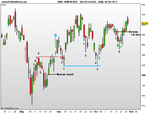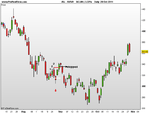Tell you what Jon - name 1 pattern and tell me the probability of the outcome being one way or the other. Any pattern from your 30 years as a trader and give me the probability of a continuation or reversal.
toastie
Ooof! I trade potential trend continuation after 3+ bar retracement. I will duck the %age probability for reasons that will become clear in the two examples.
First up ARM:
Early August and ARM is in swing downtrend and makes a 4 bar retracement that triggers a short.
Even though the trade was marginally profitable, you'd have to say the "pattern" failed because price did not go on to new lows and meet the
assumed expectation.
It then makes an
assumed change of swing trend to up - blue arrow - and the first 3 bar retracement after that met the continuation
assumption but I didn't trade it because of the gap opening.
Then a messy 4 bar retracement and a long triggered which, although profitable, again failed to meet the continuation expectation.
Another 3 bar retracement from the level it did make and I'm in long again, although I've bent the rules a bit to do it - we'll see if I'll suffer for my naughtiness
🙂
Now AVIVA
On this one I merely show a failed short trade where price then went on to meet the continuation
assumption briefly and then properly after the false start.
I'll leave you to look for other 3 bar retracements in the chart and judge for yourself how they fared
😉.
Now there's absolutely nothing magical, nor particularly rational, about the so called "pattern" - all it does for me is to throw up levels where I choose to make an
assumption and where I am prepared to risk a trade on that
assumption.
jon


